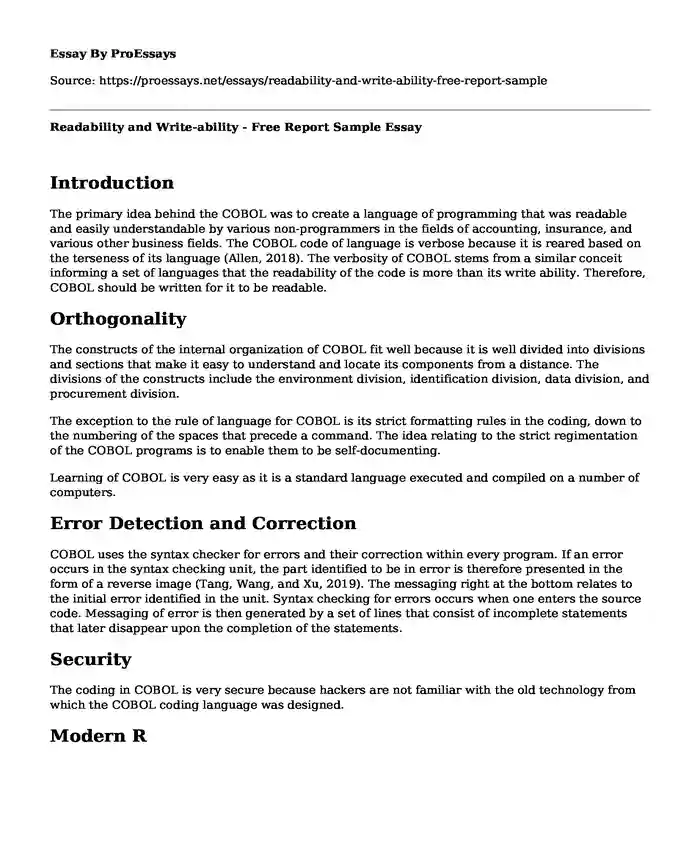Introduction
The primary idea behind the COBOL was to create a language of programming that was readable and easily understandable by various non-programmers in the fields of accounting, insurance, and various other business fields. The COBOL code of language is verbose because it is reared based on the terseness of its language (Allen, 2018). The verbosity of COBOL stems from a similar conceit informing a set of languages that the readability of the code is more than its write ability. Therefore, COBOL should be written for it to be readable.
Orthogonality
The constructs of the internal organization of COBOL fit well because it is well divided into divisions and sections that make it easy to understand and locate its components from a distance. The divisions of the constructs include the environment division, identification division, data division, and procurement division.
The exception to the rule of language for COBOL is its strict formatting rules in the coding, down to the numbering of the spaces that precede a command. The idea relating to the strict regimentation of the COBOL programs is to enable them to be self-documenting.
Learning of COBOL is very easy as it is a standard language executed and compiled on a number of computers.
Error Detection and Correction
COBOL uses the syntax checker for errors and their correction within every program. If an error occurs in the syntax checking unit, the part identified to be in error is therefore presented in the form of a reverse image (Tang, Wang, and Xu, 2019). The messaging right at the bottom relates to the initial error identified in the unit. Syntax checking for errors occurs when one enters the source code. Messaging of error is then generated by a set of lines that consist of incomplete statements that later disappear upon the completion of the statements.
Security
The coding in COBOL is very secure because hackers are not familiar with the old technology from which the COBOL coding language was designed.
Modern R
Simplicity
Readability and Write-ability
Modern R is very simple to use and also intuitive. For instance, a linear regression program can be computed using the lm command meaning that fitting a model of the linear regression can use a response y and a predictor x (Baumer, Kaplan, and Horton, 2017). Modern R applies the working directory, this directory is found through the command getwd or the get working directory and it can be replaced with the setwd command. This
Orthogonality
The constructs of the R coding language fit well as it involves an integrated set of suite involving software facilities meant for the manipulation of data, graphical display, and calculation. The R programming language design is fully planned and also a coherent system.
There are so many exceptions to the rules of the language of modern R because it provides a wide range of nonlinear and linear modeling, time analysis, and also graphical techniques which are all highly extensible.
Modern R is very easy to understand because of the ease with the design of the quality publication plots are produced, this includes formulae and mathematical symbols when needed.
Error Detection and Correction
When the program is running, data, functions, and variables are all stored in a set active memory in the design of objects that have a name. The user therefore can detect errors and make corrections on these particular objects with the use of the operators, which is logical arithmetic, or by comparison (Rabe, Vasishth, Hohenstein, Kliegl, and Schad, 2020).
Security
The program is not so secure from hackers because its programs are much more extensive and therefore easily traceable by hackers.
References
Allen, B. (2018). Common language: Business programming languages and the legibility of programming. IEEE Annals of the History of Computing, 40(2), 17-31.
Baumer, B. S., Kaplan, D. T., & Horton, N. J. (2017). Modern data science with R. CRC Press.
Rabe, M. M., Vasishth, S., Hohenstein, S., Kliegl, R., & Schad, D. J. (2020). hypr: An R package for hypothesis-driven contrast coding. Journal of Open Source Software, 5(48), 2134.
Tang, F., Wang, Z. Y., & Xu, K. (2019). Discussion and Practice of the Reform of Cobol Language for the Z/900 Course.
Cite this page
Readability and Write-ability - Free Report Sample. (2023, Dec 18). Retrieved from https://proessays.net/essays/readability-and-write-ability-free-report-sample
If you are the original author of this essay and no longer wish to have it published on the ProEssays website, please click below to request its removal:
- Digital Diplomacy Essay
- Assignment Example on Digital Solutions
- Technical Skills of Csirt Team: Reply to Student's Post Paper Example
- Google - A Car Manufacturer?
- Interesting Things for a Computer Programmer - Essay Sample
- Psychological Difficulties Linked to Problematic Internet Usage Among Young Individuals - Essay Sample
- Essay Example on Unlock the Power of the Internet: Its Impact on Politics







